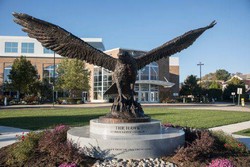The Football team and other student-athletes participated in the Hawk Walk where the University community walks around campus before the football game on Homecoming.
The walk consisted of sports teams, the Spirit Squad, alums, parents and fans joining the football onto the field before the Homecoming game.
The gathering started at the circle between Rechnitz and Wilson Hall, where there were light refreshments.
“The idea for the Hawk Walk started with the football program, who have done the actual walk for a few years. They (Athletics Marketing) approached us about adding in the Spirit Squads, Shadow the Hawk and fans/parents of players. From there it expanded to include alums and various on-campus groups,” said Eddy Occhipinti, Associate Athletics Director/Marketing and Sponsorships. “It really has been an organic, Monmouth-made idea that grew from the football team and now includes all areas of the University.”
The connection is making its way around campus. This past week, the Hawk Walk included various teams, among them Women’s Lacrosse, Women’s Soccer, Men’s Soccer, Field Hockey and Track & Field. “I think it’s a good idea and a step in the right direction and hopefully in years to come all athletes can support each other,” said Madie Gibson, a senior Women’s Soccer player.
Jon Roos, Senior Associate Athletics Director/External Affairs, explained that the Hawk Walk “combined effort from football and athletics marketing.” He then added, “Then we collaborated with Student Life, Residence Life, Admissions, and Alumni Engagement.” The hope for the Hawk Walk is for it to become a tradition throughout the campus. The University hopes to, “continue to build pride on this campus and utilize the new Hawk sculpture as the ‘heart’ of the campus,” said Roos.
“While the idea for the Hawk Walk was born with the football team, the hope is that it becomes a point of pride for every student, alum and fan and the actual path taken by the football team for the Hawk Walk becomes something special for everyone that does it,” said Occhipinti.
“It shows the connection different Monmouth athletic teams have with one another, the support that we give each other feeds off around campus and just brings our university together,” said Drew Ashley, senior Defensive Back.
“Football is a weird game, like hockey and men’s lacrosse. Unfortunately, it is impersonal because everyone is wearing a helmet and it is hard to see that there are actual people under those helmets. Therefore, when you see the players face-to-face and eye-to-eye, it is like ‘oh wow, that is a fellow student of mine’ or ‘I have class with this person,” said Jennifer McGovern, Ph.D., an assistant professor of sociology.
McGovern continued with, “it (The Hawk Walk) can connect people because it brings out the humanity of the game from the fans, and the players to can see the fans are coming to watch and support them,”
The players get to see their friends, family and fans in person during the six-minute Hawk Walk. “[There’s] a sense of community and being a part of something bigger here at [Monmouth.] It’s nice going to your game and seeing all the other sports teams here supporting you; like one big family supporting each other,” said Offensive Lineman John Gallina. “You see all the students, parents and faculty out there it really gets your pumped to play a great game.”
Another side of this is the mental effect of the Hawk Walk, and specifically how rituals like it, affect the players and their performance. “What we do know from studying sport both sociologically and psychologically is that ritual helps people. Ritual gets people pumped and ready. Athletes seem to do the same things before every game so the idea of having a ritual is something that can get people very mentally ready, and what is interesting about the Hawk Walk, is that it would depend on the individual players and whether this ritual pumps them up,” said McGovern.
“If you feel like you’re connected to your institution, you feel like you’re a part of it and what we know as sociologists is that whenever someone feels a part of something, they feel like what they are doing has meaning and purpose,” said McGovern. The players, she feels, perform better and become more invested when a tradition exists that can boost their sense of affiliation and belonging.
“Many colleges have their own version of the Hawk Walk,” said Head Coach Kevin Callahan. We see many different college campuses have something similar to this; Auburn has the Tiger Walk, a tradition that stems back to the 1960’s. Virginia Tech plays Enter Sandman by Metallica to ignite the Hokies, several teams do a Tunnel Walk and at Notre Dame, painting helmets gold is a game-day tradition they hold dear.
The Walk ended at the new Hawk Statue at Brockriede Common, in front of the OceanFirst Bank Center. The Pep Band played a cover of the University’s “Fight Song.”
The Hawks head football coach agreed that the idea of the Hawk Walk is a way to show school spirit in a new and profound way and it’s something he and his players are happy to be a part of.
PHOTO COURTESY of Matt Aquino




